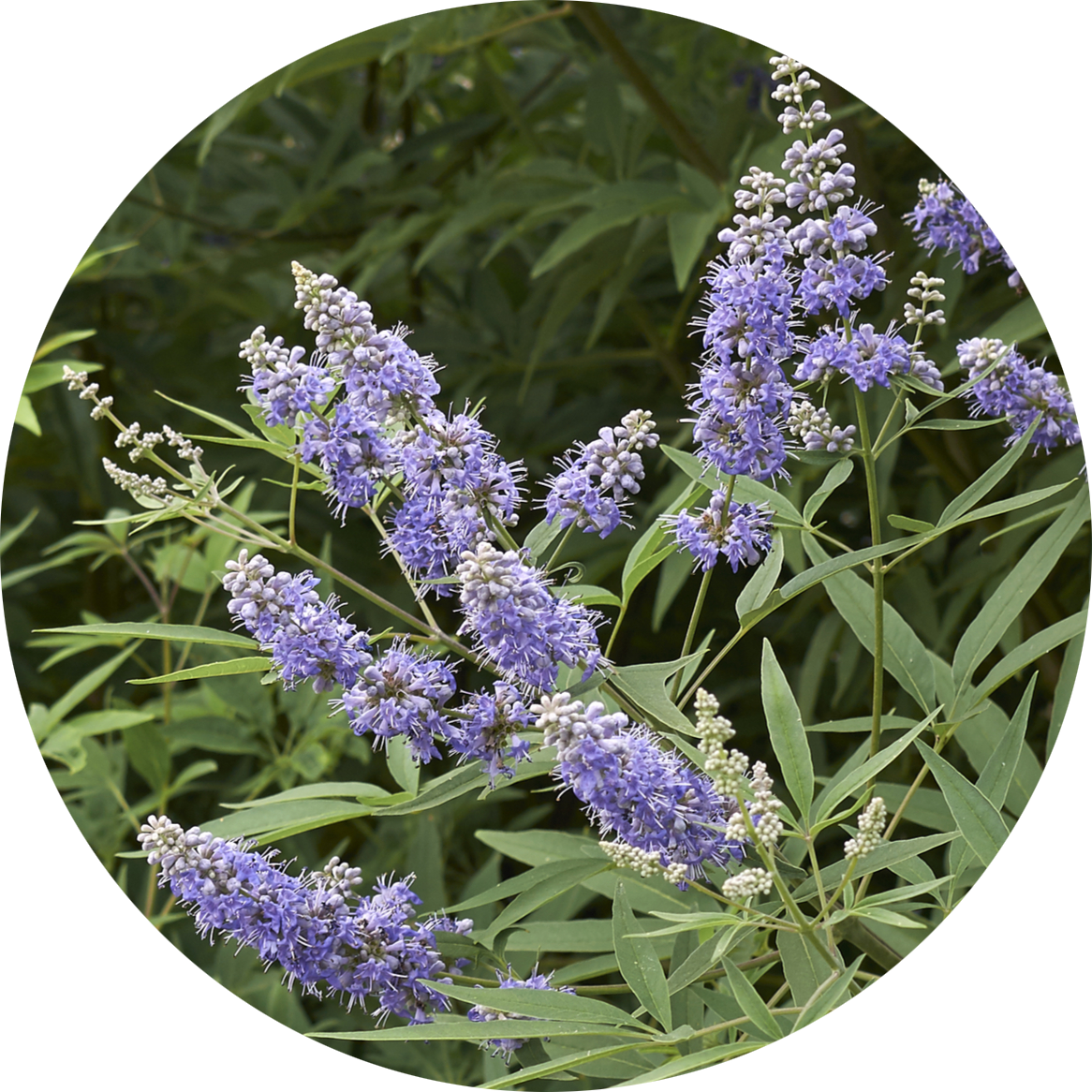(Vitex agnus castus)
When hormones create chaos in our body, Mother Nature has a way of bringing them back into harmony. Phytoestrogens are compounds found in certain plants that have the ability to mimic oestrogen. They are also present in foods that are in everyday use, such as cereals, legumes and nuts, and are especially present in some medicinal plants, one of them being chaste tree. Vitex agnus castus, a shrubby plant that can grow up to five metres in height, a member of the Lamiaceae family (formerly classified in the Verbanaceae family), has been used for thousands of years in traditional medicine to regulate menstrual cycle in women, but also to reduce sex drive in men. For this reason, its English names are “chaste tree”, “chaste berry” or “monk’s pepper tree”, precisely because monks often used it to reduce libido. It originates from the Mediterranean, from where it quickly spread throughout Eurasia, and today is grown everywhere as an ornamental plant. Although it thrives in areas where winters are not severe, even if the plant fails due to frost, shoots will sprout again from the root and the plant will regenerate quickly. Its scientific name Vitex was coined by Pliny the Elder, pointing to the suppleness of chaste tree branches which are often used to weave baskets. Chaste tree has elongated leaves and a beautiful, clustered purple flower with a sweet scent that bees especially love because it is good for honey.
CHASTE TREE – FOR AND AGAINST
This exceptional plant is rich in flavonoids, especially vitexin, alkaloids, glycosides, diterpenes, oils, and especially steroid hormones, which confirms its traditional use. By having an impact on the functioning of the pituitary gland, chaste tree leads to an increase in progesterone; it does so by directly increasing the level of luteinising hormone and inhibiting follicle-stimulating hormone and reducing the level of prolactin. Thus, this plant has been proven to affect female fertility, especially in women who suffer from imbalances in the luteal phase of the cycle and have high levels of prolactin, which is why they fail to get pregnant. As it can cause ovarian hyperstimulation, chaste tree also increases the risk of miscarriage. Therefore, it should be used with caution. It is also not suitable for women who use oral contraceptives because it can reduce their effect. As it lowers the level of prolactin, the hormone responsible for milk secretion, it is not suitable for breastfeeding women either.
Who benefits most from chaste tree? Women in the reproductive period who have sensitive and painful breasts during PMS can rid themselves of this unpleasant symptom with the help of this plant, thanks to its ability to reduce the level of prolactin that causes it. It can also help with other PMS symptoms such as bloating, cramps, menstrual back pain and mood swings. Women entering menopause benefit the most from it.
SALVATION IN PERIMENOPAUSE
Perimenopause is a period when the first symptoms of menopause begin to appear between 45 and 50 years of age, until the final entry into menopause, officially one year after the last menstruation, which occurs on average around the age of 51. Symptoms of perimenopause are numerous and unpleasant: hot flashes, sweating, nervousness, insomnia, anxiety, mood swings, irritability, forgetfulness, mental fog, chest pain, joint pain, headache, dry skin, dry mucous membranes, vaginal dryness… From this time on, women are particularly prone to weight gain and more susceptible to disorders such as diabetes, cardiovascular disease and osteoporosis.
As oestrogen levels drop dramatically at the onset of perimenopause, other hormones also begin to oscillate, resulting in all the aforementioned symptoms and major changes in the menstrual cycle – either reduced or excessive bleeding. And that is where chaste tree comes into play. With its ability to reduce prolactin levels, this plant has been proven to balance the cycle, prevent vaginal dryness, chest pain, reduce the intensity and frequency of headaches and mental problems that may be even more unpleasant. Phytoestrogens have a beneficial effect on cognitive function, so chaste tree can help us think more clearly, remember better and improve our focus – which is otherwise difficult in perimenopause. The effect of chaste tree on vasomotor symptoms – hot flashes and sweating – is noticeable and especially useful for women who for any reason cannot use substitution therapy.
Chaste tree is also a powerful antioxidant – it slows down ageing and prevents oxidative stress and atrophy; with its strong anti-inflammatory effect thanks to the flavonoid casticin, it prevents joint pain and other inflammatory processes that are common during this period. Vitex essential oil also has a strong antimicrobial effect which helps the body fight pathogens. Another reason why women should embrace chaste tree in the transition period is its proven ability to heal and strengthen bones, which is valuable if we know that with a drop in oestrogen bones begin to become thinner, thus increasing the risk of osteoporosis. Some women during perimenopause can literally feel the oscillations of hormones on their own skin – through acne. Chaste tree can also help with this, because it has an antibacterial effect, in addition to calming hormones. German Commission E recommends 40mg of chaste tree a day as treatment for acne.
For all these reasons, chaste tree is part of a new preparation from the Herba Svet laboratories – Femisan Gold – intended for women who are approaching menopause. Along with chaste tree, this completely natural preparation also contains extracts of wild yam, hops, black cohosh, angelica and ginseng, which help women in the “golden age” with their phytoestrogen action to maintain the protective effect of hormones, provide holistic health care and eliminate the unpleasant symptoms of menopause. Femisan Gold – for a carefree golden age full of wisdom and experience!

